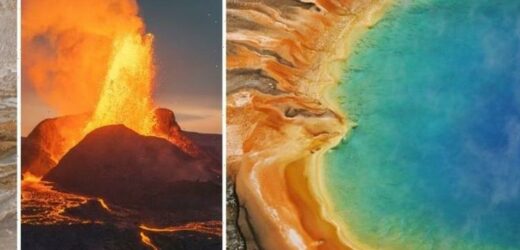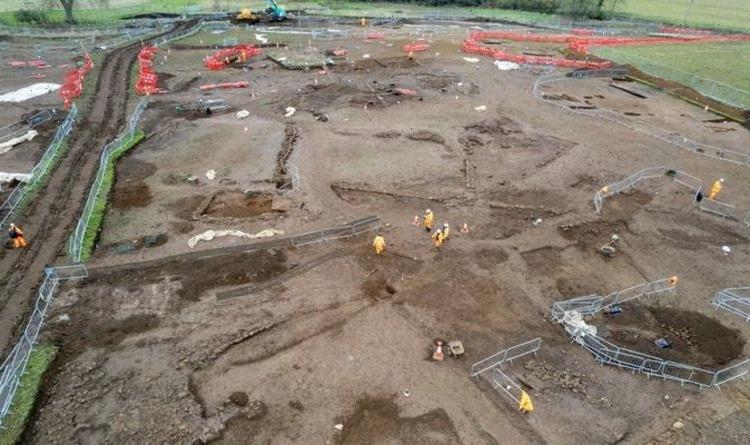Yellowstone supervolcano: Expert on ‘danger’ of Caldera in 2015
We use your sign-up to provide content in ways you’ve consented to and to improve our understanding of you. This may include adverts from us and 3rd parties based on our understanding. You can unsubscribe at any time. More info
Yellowstone is one of a dozen supervolcanoes on Earth, each at least seven times more powerful than Mount Tambora, which produced the biggest recorded eruption in history. Supervolcanoes have a Volcanic Explosivity Index [VEI] of eight, the highest value on the index. In the past 2.1 million years, Yellowstone has erupted three times, the most recent having occurred roughly 640,000 years ago, and was 1,000 times bigger than the devastating Mount St Helens eruption of 1980. The main feature of a supervolcano is the large magma chamber, an underground reservoir filled with hot, flowing rock.
Yellowstone is said to be due an eruption based on the cycle of previous eruptions, though it is generally accepted that anything within the next 10,000 years is unlikely.
This has not, however, stopped fieldworkers modelling prospective eruptions, as explored during Naked Science’s documentary, ‘Super Volcanoes’.
It is here that Eric Meyers, the documentary’s narrator, revealed how post-eruption, life within a 500-mile radius of Yellowstone would cease to be normal.
In 2004, scientists looked into the effects of past eruptions and used them to predict what might happen in any modern day eruption.
While the eruption itself would be devastating, Mr Meyers explained: “For those who survive the explosion, it could get worse.


“DNA evidence suggests that the last supervolcano eruption created a mini Ice Age that nearly led to the extinction of the human race.”
He continued: “An eruption of the Yellowstone supervolcano would cause widespread devastation across the United States.
“On the first day, those spared by the initial blast would face pyroclastic flows that would sweep out from Yellowstone, destroying nearly everything within 60 miles.
“Three days after the eruption, normal life within 500 miles of the volcano would be impossible.
“Within a week, the centre of the US would be buried under a thick carpet of ash, killing thousands with a painful lung disease.”

Professor Michael Rampino, a geologist at New York University, considered how the deadliest part of the supervolcano eruption would be the gases that remain in the air, rather than the ash that falls to the ground.
He visited an old tombstone in New Hampshire that reports the events of 1816, a year that became known as the ‘Year Without a Summer’.
Severe climate abnormalities caused average global temperatures to decrease by 0.4℃ to 0.7℃.
Evidence suggests that this was caused by the 1815 Mount Tambora eruption — the most powerful recorded eruption in history.
Prof Rampino said: “This is a memorial to a farmer named Reuben Whitten who managed to save the town of New Hampshire by growing enough wheat on his land to feed the community.
DON’T MISS:
Yellowstone supervolcano warning after magma chamber discovery [REVEALED]
Mountain range disappeared into Yellowstone supervolcano magma chamber [INSIGHT]
NASA’s bold plan to save planet from disastrous supervolcano eruption [EXPOSED]

“There was snow in June and frost in July, and again in August, that killed most of the wheat in the lowlands.
“But Reuben Whitten managed to grow enough wheat in the highlands here to feed the town.”
In 1816 the growing season in New Hampshire dropped from 120 days to just 16, with bad weather having caused harvests to fail in Europe and across the world.
Though 10,000 miles away from New Hampshire, the Mount Tambora eruption offers a clue as to the potential aftermath of a Yellowstone eruption as Prof Rampino explained that droplets of sulphur dioxide were spread worldwide by stratospheric winds.
These droplets cut out some of the sunlight, and the sun therefore appears dimmer.

This dimmer effect caused the famine of 1816.
Some estimates suggest Tambora killed 71,000 people — twice as many as the devastating 1883 eruption of Krakatoa — mainly through famine.
A supervolcano would likely have an even greater effect.
Prof Rampino said: “We estimate that the drop in temperature globally after a Yellowstone-sized eruption would be about 10℉.
“Now, that is a very severe cooling.
“Frost and snowfall even in equatorial regions. Tropical vegetation has no cold hardiness.
“So a frost in the tropics would kill off all the above ground vegetation.”
The loss of a growing season of one or two years could see “billions of people” killed, he claimed.
Source: Read Full Article


